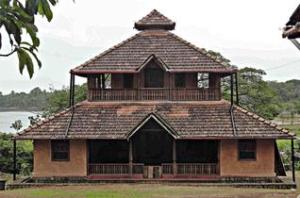Blog Archives
Evergreen ideas
The Heritage Village in Manipal, where old mansions have been relocated, gives us valuable lessons in eco-friendly construction principles.
 Much has been written about the eco-sensitivity of our traditional buildings and how they are a good fit for their climatic contexts. While it is imperative to travel to their actual location for a proper study of such aspects, for a quick understanding one could observe them in a relocated context also, at the Heritage Village located in Manipal.
Much has been written about the eco-sensitivity of our traditional buildings and how they are a good fit for their climatic contexts. While it is imperative to travel to their actual location for a proper study of such aspects, for a quick understanding one could observe them in a relocated context also, at the Heritage Village located in Manipal.
Singularly started by Vijayanath Shenoy, and built up over a few decades with a small team, the centre has 36 heritage buildings, all shifted from elsewhere and reassembled here, besides having thousands of traditional items and artefacts.
Majority of these houses have substantial areas without walls, saving not only on the wall resources, but also reducing the energy required to light up and ventilate indoor spaces. Front entrance verandahs, often beyond 20 ft. depth in two or three raising levels, function as our modern living rooms, open to glare-free indirect day light.
These semi-open spaces do not get direct breeze, yet have cool air thanks to the external edges of the verandahs screening off the wrath of direct wind, sun and rain. In a sense, they are as much climate controlled as are our modern spaces, but without any energy consumption.
High plinth
The high plinth may have expressed social status, but from a climatic consideration, they reduce ground-level dust from entering the house, safeguard it from rain and reduce the risk of raising dampness reaching the floor levels. Also, the sloping roofs with low heights project wide out to keep the rains away from the walls and the open verandahs.
The upper floors, when provided, became the preferred sleeping area with good breeze across the perforated walls letting in cool air. Being a floor-based lifestyle with very few tables and cots, the wall openings were provided at floor levels, to create comfort during any hard task. The upper floors also created spatial segregation then required between men and women or between storing and living.
To define if the green sense of our good old mansions was design driven or were they culturally created is difficult, for the design and lifestyle are complimentary, even while both being derivatives of their climatic contexts.
The idea is not to blindly glorify the heritage homes, for they too have their share of criticalities in dark interiors created by lack of light or small cell-like rooms limited in size due to limitations of structural possibilities. While some houses could overcome these imperatives by courtyards or long wooden beams, the majority could not.
However, the fact that our earlier generation found comfort in such homes and they continue to be eco-friendly with low carbon footprint cannot be denied. With thousands of such ancestral homes still being inhabited in India, it proves that these time-tested design ideas can last many more centuries in rural India and the spirit of these homes can be adapted in urban India.